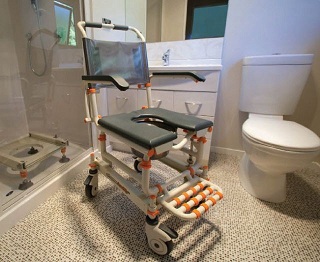Blog Roll: (Contributors)
» Hulet Smith, OT
» Megan Smith, PT
» Mike Price, OT
Topics:
Adaptive Devices
Adult Tricycles
Air Purifier
Allergy
Alternative Communication Devices
Alzheimer's Dementia Products
Aquatic Products
Arthritis Relief Products
Autism
Back Relief
Ball Pit/Pool
Bariatric
Bath Benches
Bathtub Lift
Bed Rails
Bedsores / Decubitus
Bidet
Body Solid Exercise Products
Breast Feeding Products
Bushel Trucks
Cancer
Catheters
CEU
Changing Bench
Child Car Seats
Child Care Products
Christmas Gifts
Clinic/Medical Equipment
Clinical Furniture
Cold and Flu
Communication Devices
Compression Garments
Computer Products
CPAP
Crutches
Daily Assistance Products
Daylight Lamps
Dental Care
Diabetes
Doctor's Office
Dysphagia
Electrodes
Electrolarynx
Emergency Preparedness
Ergonomic Equipment
Exam Tables
Exercise Products
Eyecare
Family Tricycles
First Aid Kits
Floor Scales
Fluidotherapy
Foot Drop
Foul Weather Gear
Furniture
Gait Trainers
General Articles
General Posts
Glassless Mirrors
Hand Sanitizer
Head Protection Helmets
Hearing Impaired
Heart Health
Heating Pad
Hip Fractures
Home Assistance Products
Home/Office Assistance
Hospital Beds
Hoyer Lifts
Hyperbaric chamber
Hyperthermia/Hypothermia
Ice/Hydration Carts
Impotence Products
Incontinence Products
Infection Control Gowns
Inspirational Stories
Lift Chairs
Light Therapy
Low Vision Products
Massage Tables & Chairs
Massage Units
Maternity
Medical Facility Products
Medical Scales
Multi-Sensory Environment
Natural Healing
Nebulizers
Non-Hospital Bedding
Nutritional Supplements
Office Furniture
One-Handed Products
Operating Room Devices
Ostomy Products
Oxygen Compressors
Oxygen Concentrator
Oxygen/Nebulizer Masks
Pain Relief
Paraffin Unit
Patient Lift
Patient Lifts
Patient Restraints
Patient Transfer Systems
Pediatric Bath Chairs
Pediatric Furniture
Pediatric Learning
Pediatric Recreation
Personal Listening Devices
Personal Warming Products
Physical Therapy
Pill Organizers
Pillows
Playground Equipment
Pool Lifts
Press Releases
Procedure Chairs
Pulse Oximeter
Reading Assistance
Reference Materials
Rehab Equipment
Rehabmart News
Rehabmart Newsletter
Respiratory Health
Rollators
Saunas
Scooters
Seniors
Shower Chairs
Shower Commode Chairs
Shower Gurney
Showers Chairs
Side Access Bathtubs
Skin Tear
Special Needs Dinnerware
Special Needs Seating
Special Report Articles
Splints
Sport Injuries
Standers
Staying Home
Stethoscopes
Stimulus Reward Toys
Stress Relief
Stroke
Strollers
Summertime Products and Summertime Fun
Talking Products
Therapy Balls
TheraTogs
Thermometers
Traction Devices & Tables
Treatment Tables
Ultrasound
Vibroacoustic Therapy
Vision Products
Walk-In Bathtub
Walking Aids
Walking Boot
Weighted Wearables
Wheelchair Accessories
Wheelchair Cushions
Wheelchair Lifts
Wheelchair Ramps
Wheelchair Transfer Systems
Wheelchairs
Women's Health
Work Hardening Products
Wound Care
An Easy Way to Transfer from a Wheelchair to a Bathroom Shower
When a person survives a major stroke or an accident, or perhaps is born with a condition that impairs mobility, adaptations may involve more than simply learning to live with the limitations imposed by the condition. If it becomes necessary to use a mobility device, the bathrooms in a person's home may have to be remodeled, a messy, expensive process that adds to the chaos of life after such an event. If a person is in a rented home, they may be forced to move if the apartment or house can't accommodate a wheelchair or other mobility device.
Helping to make the needed changes easier is the Showerbuddy Shower Transfer Chair, an adaptable ergonomically designed transfer system that makes showering easier for the user. Thanks to the opening in the seat, it can also be used as a commode or an elevated toilet seat by rolling it over an existing toilet or using its included receptacle, allowing all the user's personal hygiene matters to be addressed in one easy trip to the bathroom.

The Showerbuddy system consists of a chair with a wheeled base, a stationary base that goes inside the shower, and a bridge that transfers the chair from the bathroom floor to the shower base. First, the user is placed in the chair, and belts are fastened around him or her to ensure proper positioning and to prevent falls. Next, the chair is attached to the bridge with several latches. Then the chair can be detached from the wheeled base and easily slipped backwards onto the shower base. The base may be rotated for ease in showering the user. Afterwards, simply reverse the process to exit the shower.
Thanks to parts that clip together, the Showerbuddy Transfer Chair System requires no tools for assembly and is ready to go as soon as it's put together. Maintenance and cleaning are a breeze due to a frame made from non-corrosive and rust resistant powder coated aluminum as well as stainless steel hardware and nonporous plastic moving parts such as the casters. All it takes is a wipe down with a cleaning solution and a soft cloth to keep it clean. To prevent rust and corrosion, it simply needs drying off with a towel after the user showers. The cushions for the seat and optional neck rest are made of sealed foam and can be replaced as needed with new ones.
The system is height adjustable and accessories for adapting to pediatric use are available. The seat has a comfortable cushion with a recessed spot for the user's tail bone. It will support users weighing up to 300 pounds.
The Showerbuddy was designed after its inventor's grandfather had suffered a debilitating stroke. At the time, no products existed to allow people living with severe mobility impairment to shower or use the toilet with ease while keeping their dignity intact. His grandfather had to be transferred from his bed to a wheelchair, then to a shower chair, then back. One day in the process, he fell and was badly injured. The inventor went home and built a prototype using a plastic lawn chair. From that humble prototype came the ergonomically designed Showerbuddy available for institutional and home use, allowing users to bathe and tend to personal hygiene with ease and dignity.
Fran Jablway,
Medical Consumer Writer
and
Hulet Smith, OT
Rehabmart Team Leader & CEO
